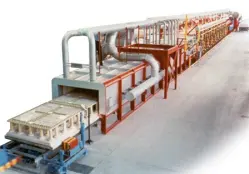Structural Clay Furnaces
Structural clay products are those ceramic products intended for use in building construction. Typical structural clay products are building brick, paving brick, terra-cotta facing tile, roofing tile and drainage pipe. These objects are made from commonly occurring natural materials, which are mixed with water, formed into the desired shape, and fired in a kiln to give the clay mixture a permanent ceramic bond. Finished structural clay products display such essential properties as load-bearing strength, resistance to wear, resistance to chemical attack, attractive appearance and an ability to take a decorative finish.
Furnace Types
- Car bottom tunnel kilns
- Roller hearth kilns
- Shuttle kilns
- Envelope kilns
Raw materials and processing
Structural clay products are made from 35 to 55 percent clays or argillaceous (clayey) shales, 25 to 45 percent quartz, and 25 to 55 percent feldspar. As with all traditional ceramic products, the clay portion acts as a former, providing shaping ability; the quartz (silica) serves as filler, providing strength to the formed object; and the feldspar serves as a fluxing agent, lowering the melting temperatures of the clay and quartz during firing. The proportions cited above are often found directly in shale deposits, so that blending is often not necessary. In addition, little or no beneficiation, or crushing and grinding of the mined material, is employed. Local clays or shales of highly variable composition are used to keep transportation costs as low as possible. The color of the finished product derives from impurities, most notably iron oxides, present in the raw materials. Colors can range from buff and other light shades of brown through red to black, depending upon whether an oxidizing or reducing atmosphere exists in the kiln.
In the processing of structural clay products, stiff-mud plastic-forming operations predominate (i.e., pressing operations for brick, extrusion for brick or pipe). Formed objects are usually fired in continuous conveyor or railcar operations, with the ware, as it traverses the tunnel kiln, proceeding from room temperature into a hot zone and finally to a cooler zone at the other end.
Properties
The properties exhibited by structural clay products are determined by particle size, firing temperature and ultimate micro-structure. Compared with finer ceramic products such as white wares, much coarser filler particles are used, and lower firing temperatures are employed—typically in the range of 1,050C to 1,100C (approximately 1,925F to 2,000F). At such low temperatures the filler particles (usually crushed quartz) are normally not affected. Instead, the clay or shale ingredients contain sufficient impurities to melt and form a glass, thus bonding the particles together. As is the case with white wares, crystalline mullite needles grow into this glassy phase. The resulting micro-structure consists of large secondary particles embedded in a matrix of fine-grained mullite and glass—all containing a substantial volume of large pores.
Because of the presence of large and small particles in their micro structures, fired clay products have relatively high compressive strengths. This ability to bear relatively heavy loads without fracture is the prime property qualifying these products for structural applications. The size and number of pores is also important. If under-fired, structural clay products have low strength and poor resistance to frost and freezing, owing to the presence of many small pores in the clay regions. Over-fired ware, on the other hand, has too much glass. It is strong but brittle and is susceptible to failure under mechanical and thermal stress. Furthermore, it is impossible to obtain a good bond when glassy products are used with mortars. Small pores and high glass content are desirable, however, when chemical resistance and impervious to water penetration are required.
Products
By some estimates, structural clay products make up as much as 50 percent of the entire ceramics market. The industry is highly conservative, with development aimed primarily at automation and labor minimization rather than the introduction of new products.
There is a wide variety of structural clay products, broadly classified as facing materials, load-bearing materials, paving materials, roofing tile and chemically resistant materials. Examples of facing materials are face brick, terra-cotta, brick veneer, sculptured brick, glazed brick and tile and decorative brick. Building brick, hollow brick and structural tile for floors and walls are examples of load-bearing materials. Paving materials include light traffic pavers, quarry tile, and paving brick—this last product once in more common use than at present. Roofing tiles are quite common in many parts of the world, red and black colors being of particular note. Chemically resistant materials include sewer pipe, industrial floor brick, drain tile, flue liners, chimney brick and chemical stoneware.







